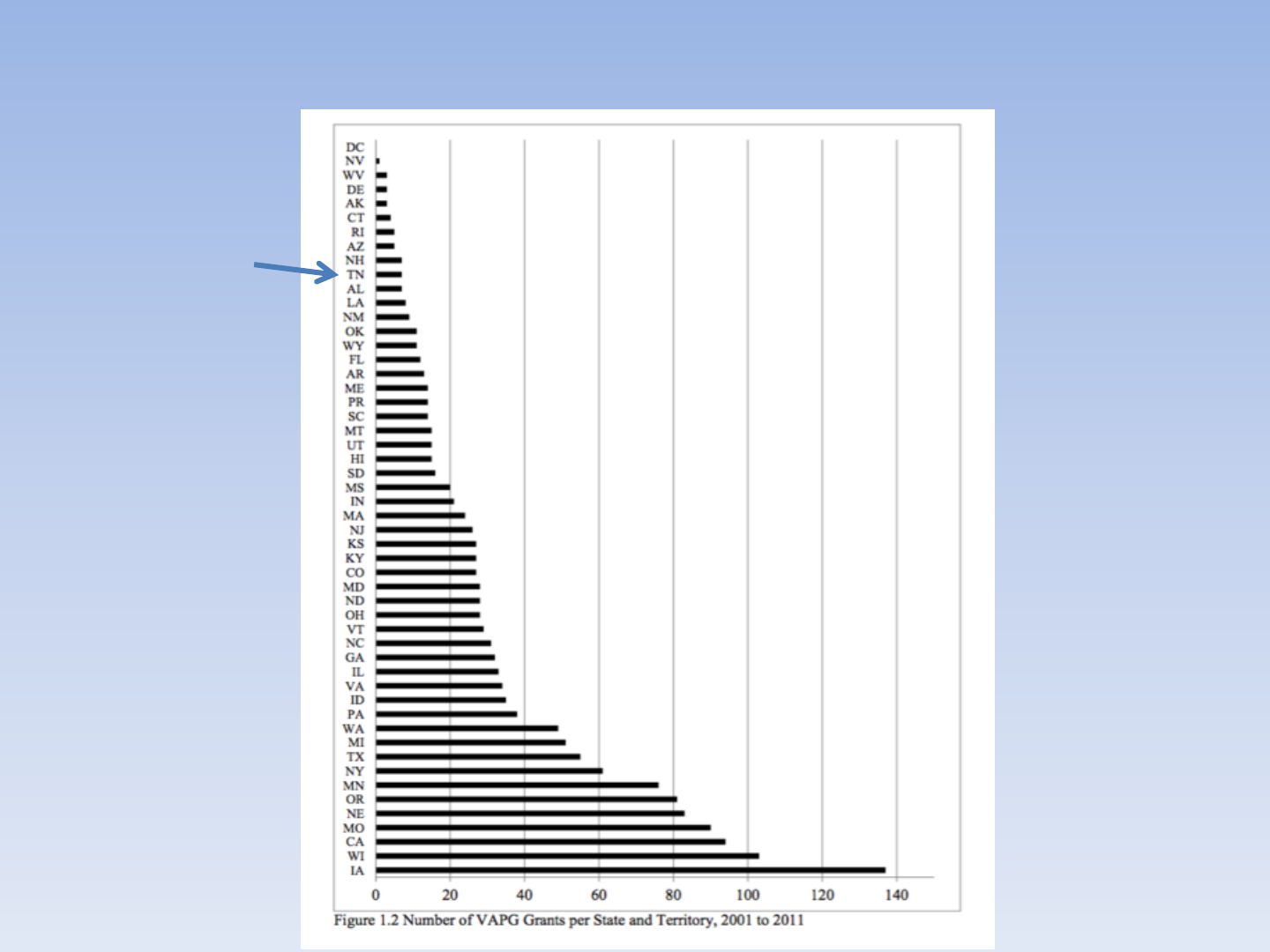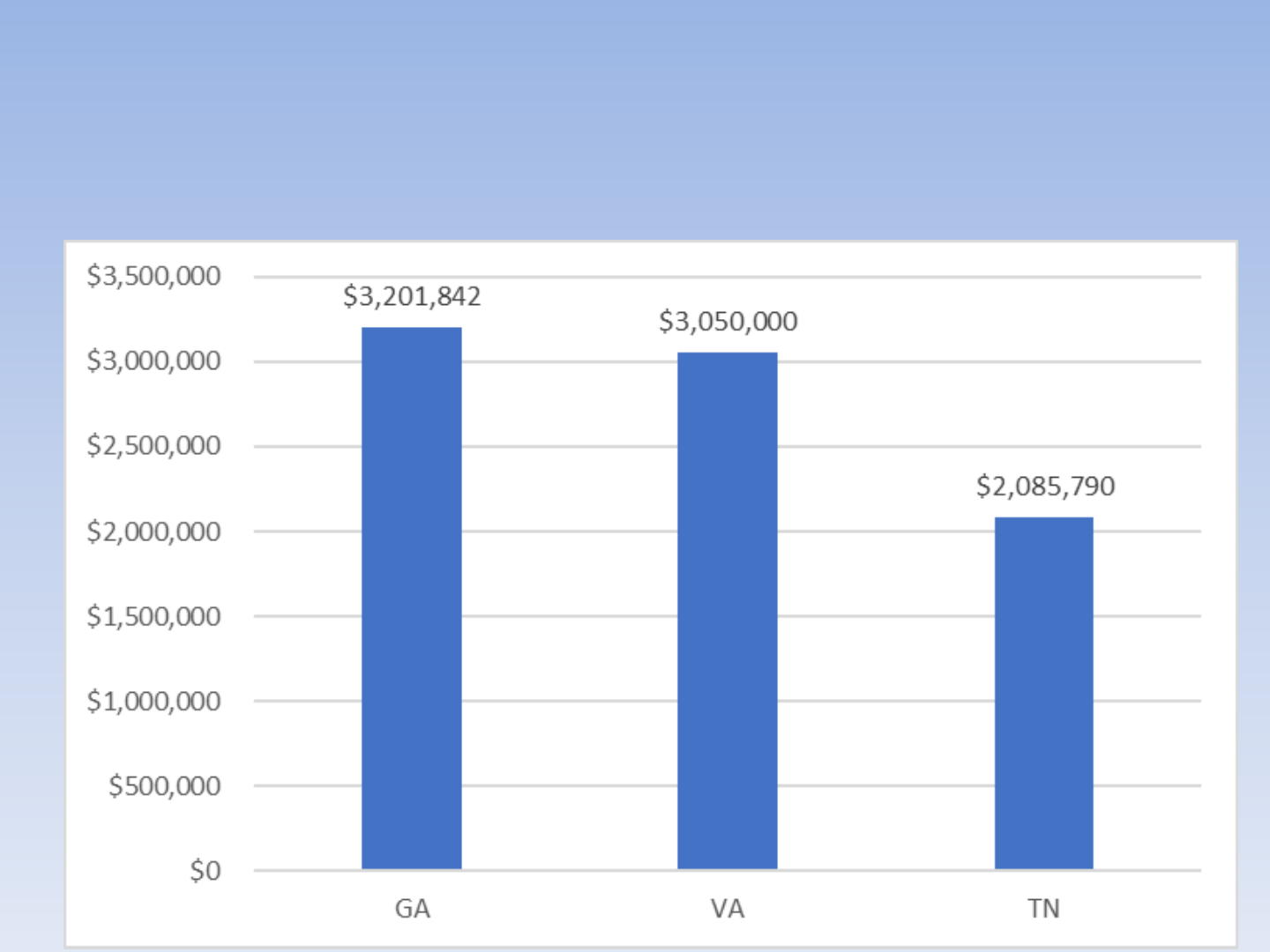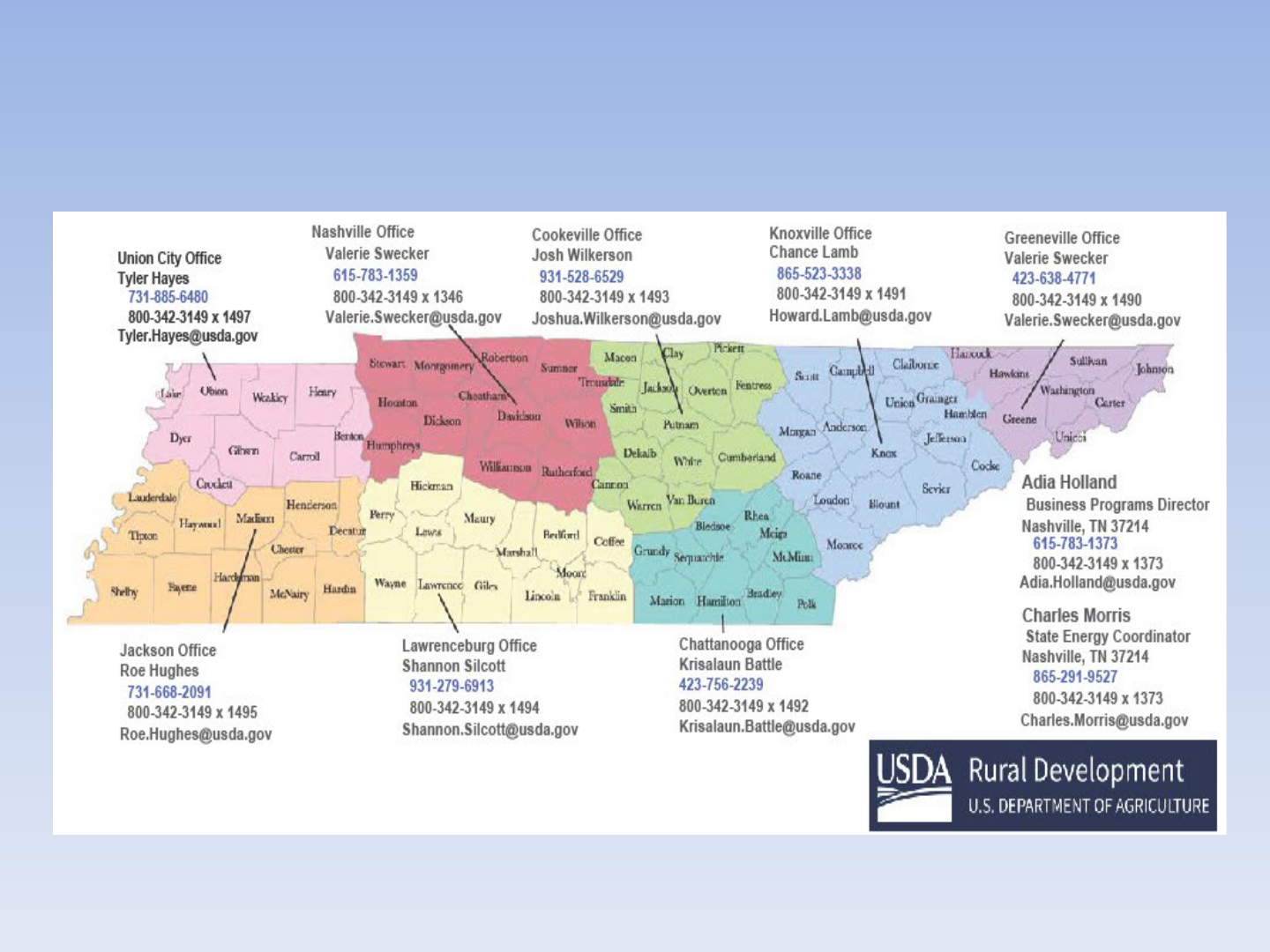
Steps to Submitting a Strong Package
David W. Hughes
Professor-Greever Endowed Chair in Agribusiness
Development,
University of Tennessee Extension,
Department of Agricultural & Resource Economics
Value Added Producer Grant Training
Virtual
January 25, 2021

Outline
• Why Apply?
• Who Have Received Value Added Producer
Grants (VAPG)?
• Overview of VAPG Application
• Project Scoring
• Summary

Why Apply for VAPG?
• The funding:
– Implement your dream
– Test new ideas with less personal financial risk
– Increase profitability
• The information you collect may prove useful regardless
of whether you get funded
– Facilitates collaborations
– Facilitates access to resources
• Evaluating your ideas
• Developing a business plan (and feasibility study
depending)
• Accessing other funding (other grants, loans)

Where has Value Added Producer Grants
(VAPG) Gone?
Mostly Not to Tennessee
Changing that is reason for this
training!

2001-2010: Only 8 States Behind Tennessee
0.5 per year
average
Source: CooperAg

Tennessee, North Carolina, Virginia
Awards, FY 2016
$356,654
$1,375,245
$3,914,193
$0
$500,000
$1,000,000
$1,500,000
$2,000,000
$2,500,000
$3,000,000
$3,500,000
$4,000,000
$4,500,000
TN NC VA
4
20
12
Source: Author calculations

Growth: Tennessee Awards by Fiscal Year 2014-20
Source: TN USDA-RD

Catching UP with Neighbors! GA, VA,
and TN Awards in 2020
12
14
13

FY 2015, 2018 National Awards
Type Number
Funded
Percent Average
Working Capital
2015
2018
217
219
83.4%
88%
$148,000
$145,660
Planning
2015
2018
43
30
16.6%
12%
$42,700
$37,387
Total
2015
2018
260
249
100%
100%
$130,600
$145,660
Source: VAPG NSAC Training PowerPoint; Intertribal Agriculture Council

FY 2018 Awards: The Key is an Eligible
Submission!!!!
• 556 submitted
• 378 eligible (68%)
• 66% (249 of the 378) of eligible
submissions received funding!
• Over half (178 out of 307) of those denied
funding due to being ineligible
Source: VAPG NSAC Training PowerPoint

This Round
• Total funds available for this round is at least $33 million
• Electronic applications http://www.grants.gov must be received before
midnight March 16, 2020
– To register go to the this link:
– https://www.grants.gov/web/grants/register.html
• Paper applications must be post marked by March 22, 2020
• Hand delivered to field office there March 22 by closing time
• HAND DELIVERED BEST APPROACH
• Few weeks in advance USDA-RD will review draft application
• Encouraged to contact your Tennessee Office of US Department of Rural
Development if seriously considering an application
• https://www.rd.usda.gov/tn
• 441 Donelson Pike #310
• Nashville, TN 37214.
Voice: (615) 783-1300 Fax: (855) 776-7057
• Their agency is the decision maker!
• ACTUALLY USDA-RD REGIONAL OFFICE PROBABLY BETTER (see next slide)

Regional Offices and Contacts

Two Types:
1. Planning Grants
2. Working Capital
Both Require 1 to 1 match
Apply for $125,000
Document $250,000 project
You “source” $125,000

Planning Grants
• For applicants who have not completed the required planning activities
• Can support feasibility study, business plan, marketing plan.
• funds may be used to hire planners, lawyers, accountants, or other
qualified consultants to complete the planning activities and related
expenses
• Feasibility Study:
– a report by an independent third-party that analyzes a business venture’s prospects for
success.
– It impartially lays out the features of the business plan & critiques them, analyzing the
strengths & weaknesses of the venture, & assessing its overall feasibility.
• Usually for 12 months
• Cap on planning grants is $75,000

Working Capital Grants
• Applicants must have completed planning activities:
– Business plan & financial projections required
– Exception is simplified version (next slide)
• Funds can go to:
• Marketing and advertising expenses
– legal expenses of organizing the venture
– design an accounting system
– implement a marketing program
• Certain operating or processing costs (such as salaries, supplies)
including some inventory (raw product)
• Can be up to 36 months but as little as 12 months
– Based on demonstrated project need
– Must show all grant and matching funds will be spent within the
designated timeframe
• Cap on Working capital is $250,000

Simplified Working Capital Grants
• Feasibility study & business plan not required
• But must still show increase in customer base
& revenues
• Simplified version capped at under $50,000

Overview of Grant Application Process
Based on Application Template
USE THE TEMPLATE!

First Register for:
1. DUNS Number, 2. SAM 3. GRANTS.GOV
• DUNS number
• Dun & Bradstreet (D&B) provides a D-U-N-S Number, a unique nine
digit identification number, for physical location of your business
.
• D-U-N-S Number assignment is FREE for all businesses required to
register with the US Federal government for contracts or grants.
New DUNS created within 1-2 business days.
http://fedgov.dnb.com/webform
• System for Award Management Registration (SAM)
• https://uscontractorregistration.com/
• https://www.sam.gov/portal/SAM/##11
• Can take up to 10 days!
• GRANTS.GOV (for electronic submission)
• Must have DUNS, SAM, EIN (IRS BUSINESS NUMBER)
• https://www.grants.gov/web/grants/register.html
• Same Day

The 7 Sections
• Required forms
• Section 1 Summary Information
• Section 2 Executive Summary
• Section 3. General Eligibility Requirements
• Section 4. Applicant Eligibility
• Section 5. Project Eligibility
• Section 6. Evaluation Criteria
• Section 7. Matching Funds

The 4 Required Standard Forms
• Form SF-424 Instructions
• Form SF-424, “Application for Federal Assistance”
• Form SF-424-A Instructions
• Form SF-424A, “Budget Information”
• Form SF-424B, “Assurances”
• Form AD-3030, “Representations Regarding Felony Conviction and Tax
Delinquency Status for Corporate Applicants”

Template Summary Information
Sections 1
– Basic Information
– Legal Name, DUNS, EIN, SAM,
– Applicant type
– Raw agricultural commodity, value-added product
– Purpose: Planning or Working Capital
– Amount requested
– End and starting date of grant
– Check Reserved funds IF Applicable!
– Check Priority points IF Applicable!
– Name, Affiliation of preparer

Section 2: Executive Summary
(more detailed description)
• 1. legal name of applying entity,
• 2. Planning or working capital
• 3. Applicant type
• 4. Amount requested
• 5. Project summary
• 6. project goals
• 7. How you intend to use the grant funds.
• LIMITED TO 1-Page!

Section 2: Executive Summary
Great Summary Statement
• “Creating and marketing value-added products has the
potential to significantly enhance our farm's profitability”.
• Our $125,000 in working capital funds will help pay for
processing, marketing, distribution, and sales of our pasture-
raised chickens and eggs, as well as microgreens that we
grow.”
• $125,000 in working capital funds will be used to pay labor
costs to produce artisan cheeses from organic milk and for
packaging, labeling, and promotional (new website and
product labels) expenses.
• Achieves the project goal of increasing sales and profits!
• Shows how you intend to use funds

State Your Qualifications
• State name of your farm-organization in first sentence of the
summary
• Emphasis appropriate experience, training
• Harry and Hannah Jones, owners of TN Hemp Farm, are
beginning farmers ( extra points!)
• Harry is a former University of Florida Extension Agent with 20
years experience
• Hannah is a member of the U.S. Angus Association and raised
show cattle for 12 years
• They started farming in 2012 and planted their first hemp crop
in 2015
• They both have degrees in Agricultural & Resource Economics
at UT and have completed CPA Value-Added Training

Section 3. General Eligibility
Requirements
• Mostly a series of check boxes regarding
citizenship and other topics.
• Remember to include Appendix B materials
regarding legal standing.
– E.g. Articles of incorporation
– For sole proprietors/independent producers
include a copy of your farm IRS document showing
farm income

Section 4. Applicant Eligibility
• Check a series of boxes:
– We produce the raw input to be transformed through day-
to-day field operations (i.e. we are farmers)
– Produce and own >50% of the raw input to be processed
– Are not contract producers for others
– Maintain ownership throughout processing (except Mid-
Tier Value Chain)
• Independent Producer
– Participates in day-to-day labor, management, field
operations
– Grow sweet corn by applying typical agronomic practices
on a daily basis throughout growing season and market
final crop that I own

Section 5.1 Project Eligibility
• Name input (raw agricultural product)- hemp
for Hannah and Harry
• Name value-added product – hemp oil &
animal feed as by-product

Section 5.2 Project Eligibility: Value-
Added Agricultural Product Methodology
• Another very important section
• Indicate at least one value added methodology that
best fits your value-added products
• Change in Physical State (explain the process in some
detail)
– The process for generating hemp oil from hemp is well
established and is currently legal in Tennessee and many other
states. The process is both legally and technically feasible. First
you must clean the seeds from hemp stalk and other fibers after
harvest. Second a cold press is applied to effectively crush the
seed-flowers and extract the oil….

Section 5.2 Continued
• Produced in a Manner that Enhances the Value of
the Agricultural Commodity-a non-standard method
of production that adds value
– Primarily an organic crop (such as organically grown tomatoes) that
receive a higher price than conventionally grown tomatoes
– Would need to demonstrate with price data
• Product (Physical) Segregation (non-GMO corn separate from
GMO corn)
• Farm-Ranch-based Renewable Energy (must have primary
crop input- such as dairy manure => methane => electricity)
• Locally-produced Agricultural Food Product
– Demonstrate would be sold in local food market (in-state or 400 miles)
– Demonstrate local outlets (such as farmers markets), local demand

Section 5.3 Expanded Customer and
Increased Revenue
• You must cite one or more relevant sources to
support the response statements and data below.
• Responses must be supported by project-specific
analysis, such as a feasibility study, marketing
plan, or business plan developed for the project
and included with this application;
• or, for working capital applications that do not
require submission of a feasibility study or
business plan, responses must identify a relevant
authority source or independent basis for the
response data provided.

Section 5.3 Expanded Customer and
Increased Revenue: More Revenue
• Discuss the estimated amount of the
increased revenue resulting from the value-
added product that will be available to the
applicant’s producers of the agricultural
commodity, including a baseline of current
revenues from the sale of the agricultural
commodity or value-added product, and an
estimated target number of increased
revenues that will result from the project

Section 5.3 Expanded Customer and
Increased Revenue: More Customers
• Discuss the estimated expansion of customer
base resulting from the value-added product,
including a baseline of current customers for
the commodity or value-added product, and
an estimated target number of customers that
will result from the project

Section 5.3 Describe Benefits
• Per the Agriculture Improvement Act of 2018,
working capital applicants must include a
description of the direct
or indirect producer
or food business benefits
intended by the
eligible entity to result from the proposed
project within a reasonable period
of time
after the receipt of a grant.

Describe the Benefits Example
The direct producer benefits intended include
increased sales revenue, profit and growth. We
expect to see an impact on valued customer growth
and sales within four months of grant award
extending indefinitely.
Indirect benefits include increased jobs, taxes paid
and demand for grapes.
Grape growing and the establishment of wineries
are also helping to diversify local economies and
keep land in agricultural production as some crops
become less viable.
State Direct
Benefits
When
State Indirect Benefits
State Indirect Benefits

Section 5.4: Purpose Eligibility and Use
of Funds
• Amount requested fill-in
• Use of Funds Check boxes
• Work Plan and Budget
• a. Grant Period Eligibility
• Up to 36 months from starting date depending
on complexity
• Your project activities should begin within 90
days of the date of award.

Section 5.4: Check Emerging Market Box
• Demonstrate that grant and matching funds focus on a new
product and/or new geographic or demographic markets
• ☐ I/We have not supplied the proposed product, geographic
or demographic market for more than two years at time of
application submission.
• ☐ I/We have included complete copies of a third-party,
project-specific feasibility study and business plan related
to the processing and/or marketing of my value-added
product in Appendix C. This grant project proposes to
implement the venture as outlined in the feasibility study
and business plan documents.
• Name of person completed and date for feasibility study
• Name of person completed and date for business plan

Feasibility Study and Business Plans: Very
Important Requirements for Emerging Market
• We have included complete copies of a third-
party, project-specific feasibility study and
business plan related to the processing and/or
marketing of my value-added product in
Appendix C.
• This grant project proposes to implement the
venture as outlined in the feasibility study and
business plan documents.

Feasibility Study Parts
• Background
• Market Analysis
• Site, layout, facilities
• Plant and equipment (cost structure)
• Staff
• Production and marketing plan
• Financial plan

Section 5.4: or Check Market
Expansion Box
Grant and matching funds focus on supporting sales to
new customers, with a resulting expansion in customer
base and revenue returned to producers. Market
expansion applicants can demonstrate that the focus is
on new customers by including:
– Demonstration that the project will result in an
expansion of number of customers for the proposed
project with resulting increased revenues returned to
participating producers.
– Detailed workplan, budget, and scoring criteria
discussion of project components focusing on
identification and attraction of new customers.

Market Expansion: Feasibility Study
Not Required
• Can have a feasibility study
• OR
• Can substitute a business plan or a marketing
plan

More Revenue, More Customer
Examples
• Cite industry reports, academic studies, or your own
records to support
• Industries studies (Pepper, 2020) indicate that the
demand for hemp oil has grown by …. Since 201x and is
projected to grow by…. By 2025
• Based on national data (Hemp U.S.A.), we estimate the
number of Tennessee customers using our hemp oil
will be 2,000 (from a base of 0) based on our estimated
level of production and projected demand growth
leading to at least $100,000 in revenue (from a base of
$0) based on projected production of 2,000 gallons at
$50 per gallon.

Work Plan (WP) Narrative and Budget
• Clear and concise budget
• Tie project activities to the budget

Work Plan and Budget Specifics
• 1. Describe how eligible activities will go to meeting
project goals
• 2. Show budget allocations for eligible activities
• 3. Identify key personnel for conducting or
overseeing activities
• 4. Provide a timeframe for completing activities
• 5. Show how grant and matching funds are used to
support activities
• 6. Grant period timeline meeting starting and ending
date requirements

WP: Key Personnel Activities Meeting Goals
• Webpage designed to enhance hemp oil sales will be
constructed by Dr. Jane Smith for sales growth of hemp oil;
Harry Jones will oversee activity
• An advertising firm will be hired to market hemp oil hence
facilitating market growth; Hannah Jones will oversee activity
WP: Budget Allocated to Specific Activities &
How Funds Are Used
• $5,000 will go to Dr. Smith for new website
• Advertising firm will be paid $10,000 for marketing activities
(advertising in industry magazines for example)

WP Provide Timeframe for Completing
Tasks
• May 1 2020: Initial meeting with Dr. Smith
regarding webpage design
• June 1 2020: Following up meeting with Dr.
Smith regarding progress of webpage work
• August 1 2018: Draft version of webpage
provided by Dr. Smith

Thinking Through Work Plan
Time Who Action
May 1-May
31 2020
Dr. Jane Smith,
Hannah Jones, Harry
Jones
Evaluation made of appropriate websites and preliminary
results provided to Hannah and Harry Jones
May 1-July
31 2020
Smith Construction of website for marketing hemp oil

Project Budget Summary Example
Activity #
Task Name,
Description, and
Responsible Party
Start Date End Date
VAPG
Funds
Cash
Matching
Funds
In-Kind
Matching
Funds
Total
Project
Costs
Website
Development
Dr. Smith
May 1,
2020
August
1, 2020
$15,000 $5,000 $10,000 $15,000
TOTAL PROJECT $15,000 $5,000 $10,000 $15,000

Task Budget Summary Example
(Must Provide a Budget for each Task)
Task #1 Market Analysis Study
VAPG Grant
Funds
Cash
Matching
Funds
In-Kind
Contributions
Total
Personnel (Including Contractual) $12,000 $3,000 $7,000 $22,000
Fringe Benefits
$0 $0 $0 $0
Travel $500 $500 $0 $1,000
Other (specify) $0 $0 $0 $0
TOTAL PROJECT $12,500 $3,500 $7,000 $23,000

Section 6 Proposal Evaluation Criteria:
Proposal Evaluation/Scoring Criteria
☐Nature of the Proposed Venture
☐Qualifications of the Project Personnel
☐Commitments and Support
☐Work Plan and Budget
☐Priority Points (if applicable)

Section 6.1 Proposal Evaluation Criteria:
• Number of jobs generated or saved
• Discuss how this is done:
• The increased production and sales of 25 percent annually over the
three year period of the grant at hemp operation is expected to
create and/or save 5 FTEs; a 100 percent increase in current
staffing.
• How to calculate FTEs included in form
• From section 5.3
– Current customer baseline
– Anticipated expansion of customer base
– Current baseline revenue
– Anticipated increase in revenue
• Include practical and/or logistical activities and tasks to be
accomplished (use work plan)

Section 6.1 Proposal Evaluation Criteria:
• Provide at least 1 performance evaluation criteria
• Working capital examples:
– Is project serving targeted customers?
– Have projected increases in revenue been realized?
– Project outcomes related to special topics met? (meeting
local food needs)
• Planning examples:
– Has a projected return on investment been estimated?
– Did feasibility study evaluate economic, market, technical,
financial, management feasibility aspects?

Section 6.1 Continued
• 3) Provide at least one performance evaluation
criterion for your grant project to be evaluated by, if
awarded funds. (One of the below)
• Is the project serving the targeted customer market
described in the business plan?
– New TN customers
• Has the project realized the expected commitments
from new customers?
– 2,000 new customers
• Has the project realized the expected increase in
revenues for its agricultural producers?
– $100,000 increase in revenue

Nature of Proposed Venture
(30 points)
Work Plan and Budget
(20 points)
Qualifications of Project Personnel
(20 points)
Commitment and Support
(10 points)
Priority Points
(10 points)
USDA can award 10 more points to
a given project based on program
funding priorities
6.2 Project Evaluation Scoring:
The Agency selects and ranks applications based
on responses to 5 criteria
MUST HAVE A MINIMUM OF 50 POINTS!

Priority Points
• One of six Priority Categories (check only one)
– Beginning, Veteran, Socially Disadvantaged Farmer or
Rancher
– Mid-Tier Value Chain Project
– Small-medium size family farm, ranch
– Farmer or Rancher Cooperative
• Group Applicant
– Producer group or majority controlled, cooperative
– AND creates or increases marketing opportunities for
beginning, social disadvantaged, or small-medium farms
• Administrator Priority (awarded by RD)

Nature of the Proposed Project
(30 points)
• Most important component
• Clearly describe your goals
• Support goals with published data or other 3-
party information
• Prior experience producing or marketing
value-added or similar products
• Indicate experience with similar markets or
successful ventures

Nature of the Proposed Project (30 points)
• Technological Feasibility:
– Discuss the process, potential markets, distribution channels
– Discussed technical feasibility based on similar products and/or
markets, published data, and other 3-party information
• Operational Efficiency
– Use experience, data or information, to describe or layout
operational efficiency; discuss how the process works and any
challenges
– Any anticipated challenges or risk
• Profitability
– third-party data references, trends, industry-norm or formula,
your experience with similar products or markets
• Economic Sustainability
– Expected future viability; describe known risk factors and what
might be required to sustain future effort

Nature of the Proposed Project
• 23–30 points:
• All criterion components are well addressed
• Supported by third-party information (cite
studies & have a bibliography)
• Demonstrate a high likelihood of success

Qualifications of Project Personal
(20 points)
• Identify everyone responsible for managing and
performing work plan tasks including a summary
of qualification and expertise
• Describe their roles, responsibilities,
commitment/availability
• Include education obtained
• Past and current professional experience
• Relevant training
• Especially want to include items indicating
agricultural experience

Qualifications of project personal
• 15–20 points:
• All personnel demonstrate strong, relevant
credentials or experience, and availability
• Indicating a high likelihood of project success

Commitments and Support (9-10 points)
• Independent Producer (1-2 points)
– Number and nature (level and quality) of commitment
• End Users (Customers): (2 points)
– Potential or identified markets discussed in proposal
– a letter(s) of support indicating the need for the product
– Tie this support to your proposed activities
• Third-Party providers:
– Technical or necessary help that they give, level and
qualifications
– a letter indicating their willingness to provide the technical
support as outlined in the proposal
– They need to state qualifications in the letter
– You need to highlight their qualifications in proposal
• Nature and quality of Commitment (points for cash match)
– All in-kind 1 point
– Both 2 points
– All cash 3 points

Commitments and Support
• 7–10 points:
– Show strong financial commitment to the project
in the form of cash matching contributions
– Participation from additional producers
– Measurable commitment or interest from multiple
end-users
– Commitment or tangible support from multiple
third-party contributors

Work Plan and Budget (20 Points)
• 15–20 points:
• Provide a clear, comprehensive work plan
• Detailing all project goals, tasks, timelines,
costs, and responsible personnel in a logical
and realistic manner
• Demonstrating a high likelihood of success

Administrator Priority Categories
(10 points)
• If eligible and documented up to 10 extra points
• Improves geographic diversity and/or, foster persistent
poverty counties and/or help reduce unemployment
• Must have never received a VAPG
• Discuss how workplan-budgets support 1 of 5 areas:
– Achieving e-Connectivity for Rural America
– Improving Quality of Life
– Supporting a Rural Workforce
– Harnessing Technological Innovation
– Economic Development

Section 7. Matching Funds Verification
Appendix D.1 Verification of Matching Funds:
Cash
(List where is cash match)
Appendix D.2 Verification of Matching Funds:
Loan
Describe your use of loan/line of credit
Lender must sign!!!!!
Appendix D. 3 Verification of In-Kind

Verification of In-Kind (D3.-D5)
• Nature of donated goods-service and how
used
• Justified value of good-service
• When good-service will be donated (specific
dates)
• You or family members can’t be over 25%
• Must do 7 steps for family members or others

Match
• One-One: The applicant must provide matching funds at least equal to the
grant amount in either cash or other confirmed funding commitments
• Match effort: it’s better to err on the side of conservative than it is to seek
out every penny as a match
– Remaining eligible
– Less paperwork
• Can use in-kind as match
– Same criteria for match as for spending of funds
• If it is a disallowed expenditure for the grant, then it can’t use it as a match
• Infrastructure, including machinery, is not allowed as in-kind match
– But, cash match scores higher than in-kind
– A portion of match as cash usually a good idea

In-Kind as Match
• Matching funds cannot come from other federal grants.
• Must be verifiable
• Use market rates
• Don’t over-value: church hall for meeting space, usually free so don’t put $
value on it. You have to show that it usually costs something
• Can donate your time (or someone else’s):
– for example, for feasibility study consultant provides extra work as match
– When paying for services such as consultation, you must document that
the rate is what the service provider normally receives (or must defer to
IRS set standards for the service)
– Working capital: raw materials can be used as a match
• Can use in-kind (i.e., crops that you grew)
• For a cidery, value of apples that you grew can be used as match

Priority Points Appendix E
• Check one if possible
• If eligible and documented 5 extra points
☐ Beginning Farmer or Rancher (under 10 years)
☐ Veteran Farmer or Rancher
☐ Socially Disadvantaged Farmer or Rancher
☐ Operator of a Small- or Medium-Sized Family Farm-grossing less
than $1,000,000 annually 3 years prior to application
☐ Farmer or Rancher Cooperative
☐ Mid-Tier Value Chain Project- for example “farm to school” alliance

Appendix E: Reserved Funds
• Reserved Funds (10% of total $s “initially” reserved):
☐Beginning Farmer or Rancher (under 10 years)
☐ Socially-Disadvantaged Farmer or Rancher
☐ Mid-Tier Value Chain Project
• 10% of reserved funds are also set aside for
applicants located in persistent poverty counties
– Campbell, Cocke, Fentress, Grundy, Hancock,
Johnson, Lake, Scott
– NOT the same list as the 19 distressed and 33 at
risk counties used by TDA!!!!
– https://data.tn.gov/dataset/county-economic-status/resource/539c3ceb-d08d-47e3-9c07-19fe7e6ca2fc

Summary
• Tennessee historic low levels of funding, but
that has changed!
• Start early, do registrations now
• Contact Tennessee Office, USDA-RD now!
• Use template
• Lots of work, But, can be worth the effort!

Resources
Value Added Producer Grants, USDA Rural Development
https://www.rd.usda.gov/programs-services/value-added-producer-grants
7 CFR § 4284.926 - Ineligible uses of grant and Matching Funds.
https://www.law.cornell.edu/cfr/text/7/4284.926
Farmers’ Guide to Applying for the Value-Added Producer Grant Program
20179-2020 Cycle
https://sustainableagriculture.net/wp-content/uploads/2020/01/VAPG-
Guide-2019-MC-Edits-Interactive-.pdf


